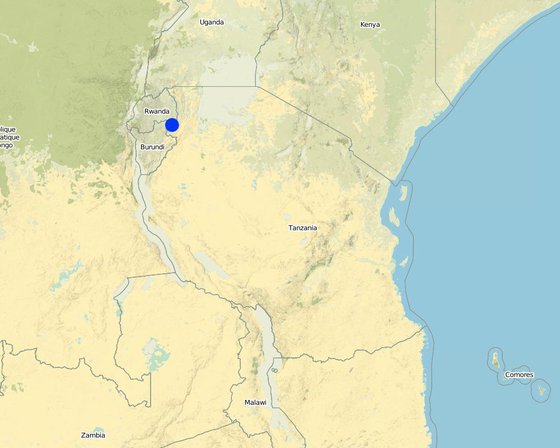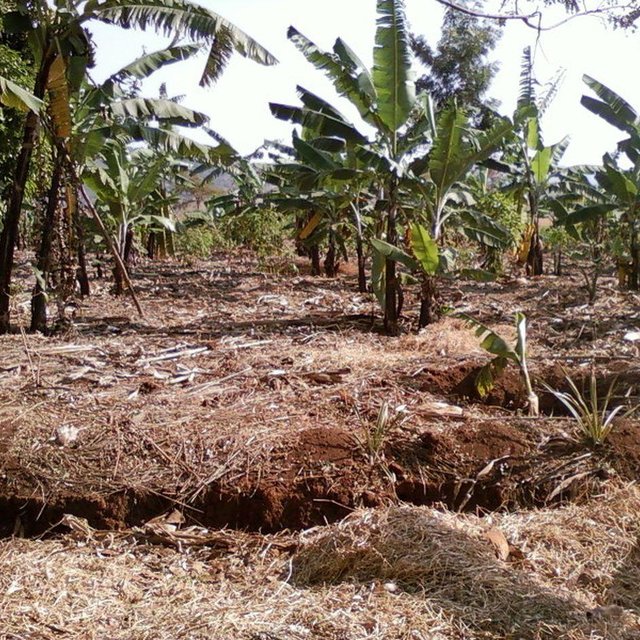

The technology was documented based on experiences of field SLM specialist and from the perspectives of land users (especially FFS group members) supported by the Trans boundary Agro Ecosystem Management project. The dominant crop in the technology area is banana. In this technology banana is widely spacing to 4m x 4m for the purpose of providing enough space for annual or recurrent soil nutrient feeding using compost ditches or baskets. Compost basket pits of 0.6 m depth and 3x3m width are dug between 4 banana plants. Baskets pits are dug recurrently and filled with farm manure, compost (crop residuals), leguminous green manure (tithonia) and ash and later covered with soil to activate nutrient release though microbial disintegration and avoid volatilization of greenhouse gas through direct sunlight. The size of a hole dug for the purpose of planting banana is 0.6 m depth and 0.6 m height. During digging top soil is separated from subsoil. In initial manure application, 2 tin of manure are mixed with the top soil and the mixture is put in the bottom of the hole. The center of the hole is marked with a stick and waiting is done for 1 or 2 before planting. During planting of banana, only two third 0.24m cubic of the hole is filling with soil and one third 0.12m cubic of the hole is left to form a water retention/harvest pit. Tithonia diversifolia (leguminous shrubs) are planted within the Kibanja farm purposefully for improving soil nutrient recycling though nitrogen fixing and at the same time is incorporate in compost to improve its quality. Infiltration ditches of 0.6 m depth and 0.6 m width and varying lengths are constructed for the purpose of impeding, trapping and harvesting water runoff. Fruit trees are planted in sub soil zone within the water infiltration ditches. The aim is to control nutrient competition between trees and annual/ biennial in the top soil or annual root zone and at the same time fruit tree roots in the subsoil zone is used as nutrient pump i.e. return nutrient lost through leaching to the top soil in form of mulching and litter. Improved banana varieties (FIAH 23) and certified endogenous germ plasma, de-trashing and de-suckering to maintain optimal plant geometry is part and per se of recommended husbandry practice
Purpose of the Technology: Improved food productivity, improved soil moisture content and water holding capacity. Improve nutrient recycling, organic matter content and biomass cycle. Prevent unproductive evaporation of green water and improving soil micro-climate. Combating land degradation through soil erosion caused by water runoff, chemical degradation due to nutrient leaching, biological degradation due the deadly BXW and other diseases and water degradation due to unproductive evaporation of the green water. And also plays significant role in adaptation and mitigation to drought climate. Improved economic returns accrued from surplus food production. Improve year round accessibility of food, shock resistance availability of food and varied food utilization and hence poverty reduction and improved health.
Establishment / maintenance activities and inputs: Establishment activities: land tilling, harrowing, demarcation and spacing of holes for planting banana, digging holes, manure application before banana planting, planting bananas, to demarcate, level and space Fanya chini/infiltration ditches/trenches using A-frame and arm outstretched level, ditch/trench digging, vegetative stabilization of Fanya chini/infiltration ditches, planting of fruit trees within ditches. Maintenance activities: weeding to destroy noxious weeds, in between planting of maize, de-suckering to maintain optimal plant geometry, de-trashing, maintenance and replenishment of banana pits, harvest beans and maize, sediment removal and repairing of infiltration ditches/trenches.
Natural / human environment: Natural (bio-physical) environment: The technology area land use type is cropland with annual crops (maize and beans), perennial crops (banana and pineapples) and fruit tree (avocados and jackfruit “Artocarpus heterophyllus”). The technology involves a combination of the following measures: agronomic, vegetative and structural. Climatic zone is sub-humid with an average of 210 length of growing period (LGP). Average slope category is gentle lying between 2-5%. Soil texture classes range from combination of top loam to a red clayey subsoil with medium soil depth categories. Main criteria for a human (socioeconomic) environment: the level of mechanization is hand tools. Production system is mixed (both subsistence and market oriented or commercial). The average costs of inputs required is 1472,62 USD. Land ownership is largely individual not titled and partly communal.

ទីតាំង: Ngara District council, Kirushya ward, Kirushya Village., United Republic of Tanzania, Kagera Region, ប្រទេសតង់សានី
ចំនួនទីកន្លែងបច្ចេកទេស ដែលវិភាគ:
ការសាយភាយនៃបច្ចេកទេស: ត្រូវបានផ្សព្វផ្សាយត្រឹមតំបន់មួយ (approx. < 0.1 គម2 (10 ហិកតា))
តើស្ថិតក្នុងតំបន់ការពារអចិន្ត្រៃយ៍?:
កាលបរិច្ឆេទនៃការអនុវត្ត: តិចជាង 10ឆ្នាំមុន (ថ្មី)
ប្រភេទនៃការណែនាំឱ្យអនុវត្តន៍៖









| បញ្ជាក់ពីធាតុចូល | ឯកតា | បរិមាណ | ថ្លៃដើមក្នុងមួយឯកតា (Tanzanian shillings) | ថ្លៃធាតុចូលសរុប (Tanzanian shillings) | % នៃថ្លៃដើមដែលចំណាយដោយអ្នកប្រើប្រាស់ដី |
| កម្លាំងពលកម្ម | |||||
| labour | ha | 1,0 | 713,15 | 713,15 | 100,0 |
| សម្ភារៈ | |||||
| tools | ha | 1,0 | 87,65 | 87,65 | 100,0 |
| សម្ភារៈដាំដុះ | |||||
| seeds | ha | 1,0 | 0,29 | 0,29 | |
| seedlings | ha | 1,0 | 65,0 | 65,0 | |
| mulching materials | ha | 1,0 | 22,06 | 22,06 | |
| ជី និងសារធាតុពុល | |||||
| compost/manure | ha | 1,0 | 44,12 | 44,12 | |
| ថ្លៃដើមសរុបក្នុងការបង្កើតបច្ចេកទេស | 932.27 | ||||
| ថ្លៃដើមសរុបក្នុងការបង្កើតបច្ចេកទេសគិតជាដុល្លារ | 0.55 | ||||
| បញ្ជាក់ពីធាតុចូល | ឯកតា | បរិមាណ | ថ្លៃដើមក្នុងមួយឯកតា (Tanzanian shillings) | ថ្លៃធាតុចូលសរុប (Tanzanian shillings) | % នៃថ្លៃដើមដែលចំណាយដោយអ្នកប្រើប្រាស់ដី |
| កម្លាំងពលកម្ម | |||||
| labour | 1499,72 | 100,0 | |||
| សម្ភារៈ | |||||
| Seeds beans (20 kg/ha) | ha | 1,0 | 8,24 | 8,24 | 100,0 |
| សម្ភារៈដាំដុះ | |||||
| Seeds Maize (2 kg/ha) | ha | 1,0 | 0,77 | 0,77 | 100,0 |
| Mulching materials (75 bundles) | ha | 1,0 | 22,06 | 22,06 | 100,0 |
| ជី និងសារធាតុពុល | |||||
| Compost/manure (325 kg) | ha | 1,0 | 9,56 | 9,56 | 100,0 |
| ថ្លៃដើមសរុបសម្រាប់ការថែទាំដំណាំតាមបច្ចេកទេស | 40.63 | ||||
| ថ្លៃដើមសរុបសម្រាប់ការថែទាំដំណាំតាមបច្ចេកទេសគិតជាដុល្លារ | 0.02 | ||||
គុណភាពមុន SLM: 25 kg
គុណភាពក្រោយ SLM: 50 kg
banana bunch
pending development and upscalling of value addition technology.
caused by use of manure and grass mulch.
due to increased production and expected income from fruit tree and pineapples
imcome from fruit trees and pineapples
caused by increased workload.
គុណភាពមុន SLM: 0 - FFS
គុណភាពក្រោយ SLM: 1 - FFS
FFS has induced farmer group solidarity and togetherness.
Increase in SLM skills and knoledge due training issued through FFS. People visiting the area where the technology is tested or demonstrated
Active participation of both men and females
Improved crop productivity and the diversification of income sources results to farmer capacity to meet eduction and health services. Production of pineapple and fruit tree (avocados and jack fruit) means increased number of food per table and balanced diet to farmer.
គុណភាពមុន SLM: poor
គុណភាពក្រោយ SLM: improved
due to the use of water infiltration ditches and fanya chini bund
គុណភាពមុន SLM: poor
គុណភាពក្រោយ SLM: improved
educed unproductive loos of green water by use of mulching.
គុណភាពមុន SLM: poor
គុណភាពក្រោយ SLM: improved
reduced unproductive loos of green water by use of mulching.
use of mulching rotated by cover crops (beans) and trashline.
Use of closs slope barriers and mulching
the use of reguminous plants (beans and tithonia)
use of farm yard manure and compost basket feeding
biomass due to improved managment of crop debris and residual and use of mulch.
improved habitat for micro fauna caused by use of manure and compost
reduced hazards towards drought and reduced growing period.
reduced volatization of methane gas due to good managment of FYM.
reduced rainfall runoff to down ward stream
reduced damage to the nearby road infrastructure